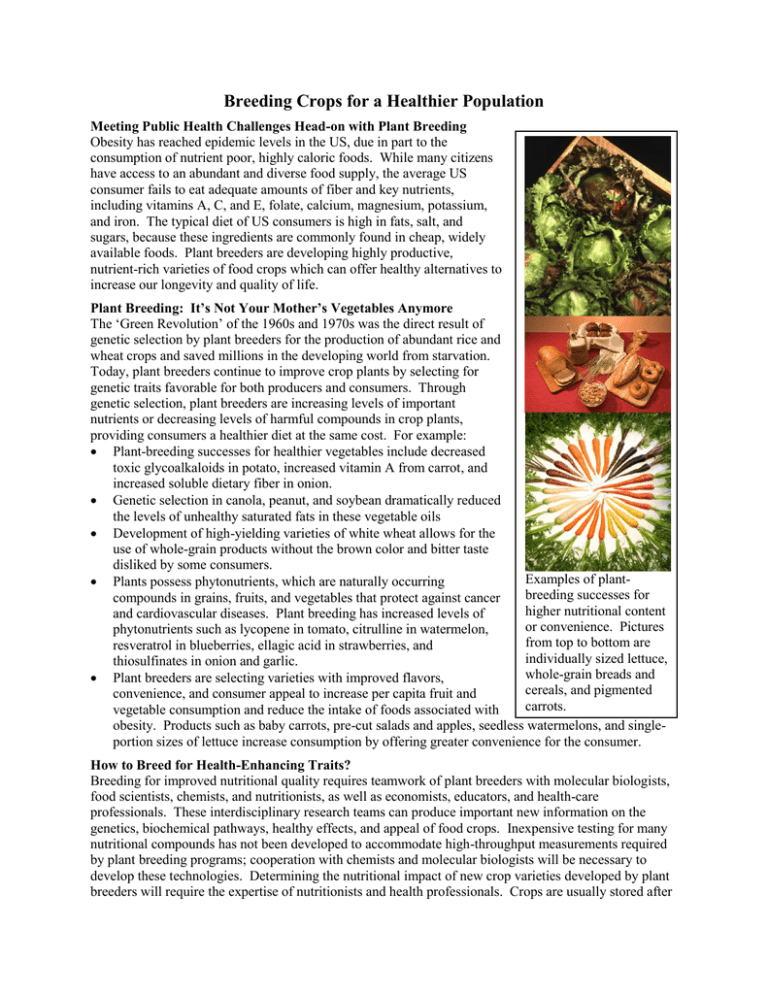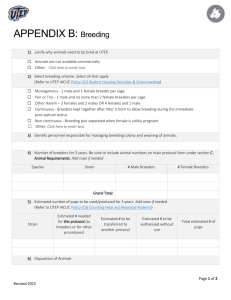Breeding Crops for a Healthier Population
advertisement

Breeding Crops for a Healthier Population Meeting Public Health Challenges Head-on with Plant Breeding Obesity has reached epidemic levels in the US, due in part to the consumption of nutrient poor, highly caloric foods. While many citizens have access to an abundant and diverse food supply, the average US consumer fails to eat adequate amounts of fiber and key nutrients, including vitamins A, C, and E, folate, calcium, magnesium, potassium, and iron. The typical diet of US consumers is high in fats, salt, and sugars, because these ingredients are commonly found in cheap, widely available foods. Plant breeders are developing highly productive, nutrient-rich varieties of food crops which can offer healthy alternatives to increase our longevity and quality of life. Plant Breeding: It’s Not Your Mother’s Vegetables Anymore The ‘Green Revolution’ of the 1960s and 1970s was the direct result of genetic selection by plant breeders for the production of abundant rice and wheat crops and saved millions in the developing world from starvation. Today, plant breeders continue to improve crop plants by selecting for genetic traits favorable for both producers and consumers. Through genetic selection, plant breeders are increasing levels of important nutrients or decreasing levels of harmful compounds in crop plants, providing consumers a healthier diet at the same cost. For example: Plant-breeding successes for healthier vegetables include decreased toxic glycoalkaloids in potato, increased vitamin A from carrot, and increased soluble dietary fiber in onion. Genetic selection in canola, peanut, and soybean dramatically reduced the levels of unhealthy saturated fats in these vegetable oils Development of high-yielding varieties of white wheat allows for the use of whole-grain products without the brown color and bitter taste disliked by some consumers. Examples of plant Plants possess phytonutrients, which are naturally occurring breeding successes for compounds in grains, fruits, and vegetables that protect against cancer higher nutritional content and cardiovascular diseases. Plant breeding has increased levels of or convenience. Pictures phytonutrients such as lycopene in tomato, citrulline in watermelon, from top to bottom are resveratrol in blueberries, ellagic acid in strawberries, and individually sized lettuce, thiosulfinates in onion and garlic. whole-grain breads and Plant breeders are selecting varieties with improved flavors, cereals, and pigmented convenience, and consumer appeal to increase per capita fruit and carrots. vegetable consumption and reduce the intake of foods associated with obesity. Products such as baby carrots, pre-cut salads and apples, seedless watermelons, and singleportion sizes of lettuce increase consumption by offering greater convenience for the consumer. How to Breed for Health-Enhancing Traits? Breeding for improved nutritional quality requires teamwork of plant breeders with molecular biologists, food scientists, chemists, and nutritionists, as well as economists, educators, and health-care professionals. These interdisciplinary research teams can produce important new information on the genetics, biochemical pathways, healthy effects, and appeal of food crops. Inexpensive testing for many nutritional compounds has not been developed to accommodate high-throughput measurements required by plant breeding programs; cooperation with chemists and molecular biologists will be necessary to develop these technologies. Determining the nutritional impact of new crop varieties developed by plant breeders will require the expertise of nutritionists and health professionals. Crops are usually stored after harvest and often processed before consumption, so collaboration with food scientists and processors will ensure that food with improved nutritional content is delivered to consumers. Large-scale production of new crops must be driven by economic incentives, and plant breeders must cooperate with economists to measure acceptance of improved varieties by consumers and processors. In the end, consumers will need information to make healthier decisions in an increasingly complex marketplace, so better communications among plant breeders, educators, and the media will be needed. If We Do Not Act and Invest Wisely If plant breeders do not develop health-enhancing foods, US citizens risk paying for a growing number of individuals with poor health. The cost of nutritious eating will continue to increase, leaving those with low-incomes no choice but to choose unhealthy foods. Children brought up without an emphasis on healthy eating will be the most severely affected. The European Union and other countries are moving forward with plans and research funding for interdisciplinary teams that include plant breeders to improve the nutritional content of their agricultural products. The US could lose domestic markets and export opportunities if our seed and commodity products are not nutritionally improved. A diverse array of nutritious crops with appealing flavor, cooking quality, color, and appearance is needed to meet the needs and expectations of our diverse population. Reaping the Benefits of A Healthy Population A healthy US population and a vibrant agricultural economy are vital to our future quality of life. While nutritional supplements are popular, food is the vehicle of choice to deliver health-enhancing compounds to consumers. Breeding crops for higher nutrient content and consumer appeal will contribute significantly to a healthier US population. Enhanced consumption of fruits, vegetables, and grains by children will help reduce childhood obesity and lead to a new generation of healthier adults, who in turn will encourage their children to continue the habits of healthy eating. However long-term success will only be accomplished if intake of essential nutrients is realized for consumers regardless of income level. Plant breeding is the motivating force for development of competitive, cost-effective crops with higher nutrient content and greater consumer appeal to the benefit of growers, processors and consumers of all ages. Recommendations: Federal funding agencies such as USDA, NIH, and NSF should increase their emphasis on nutrition and Healthy eating habits by children will support cross-disciplinary research aimed at breeding result in healthier adults. healthier fruits, grains, and vegetables. Educational outreach must communicate the benefits of healthier food crops to producers and consumers. For more information: Bouis, H.E. 2002. Plant breeding: a new tool for fighting micronutrient malnutrition. Journal of Nutrition 132:491S-494S. Simon, P.W., L.M. Pollak, B.A. Clevidence, J.M. Holden, and D.B. Haytowitz. 2008. Plant breeding for human nutritional quality. Plant Breeding Reviews 31:325-392. Wood, P.J. 2007. Cereal -glucans in diet and health. Journal of Cereal Science 46:230-238. Young, V.R. 2002. Human nutrient requirements: the challenge of the post-genome era. Journal of Nutrition 132:621-629.






